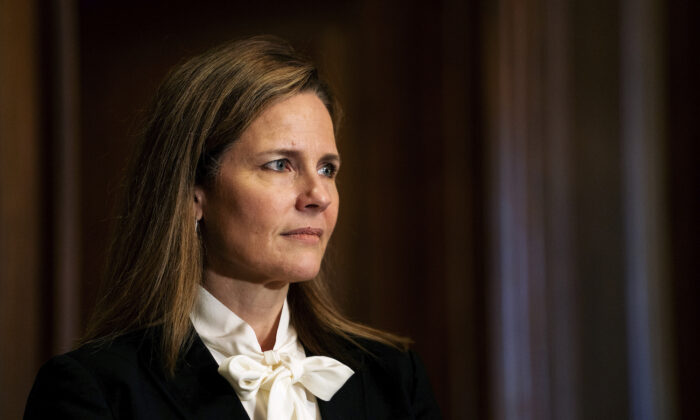Justice Amy Coney Barrett has made it clear that she will not blindly adhere to any specific judicial philosophy, such as originalism, which is predominant among conservatives on the court.
Analysis
The Supreme Court is gearing up for its first oral argument of the 2024–2025 term on Oct. 7 following a series of contentious decisions over the summer. These decisions have sparked significant media attention and speculation, with one justice standing out as the focal point for the upcoming term.
In just two terms on the court, Justice Barrett has emerged as one of the most discussed members, making unexpected moves that diverge from her conservative peers and hint at an element of unpredictability for legal experts to analyze.
Appointed as the final nominee of former President Donald Trump, Justice Barrett succeeded liberal icon Ruth Bader Ginsburg, raising concerns about a lasting conservative tilt with a 6–3 majority on the bench.
Despite initial fears, her recent rulings suggest she leans more towards being a swing vote akin to former Justice Sandra Day O’Connor rather than aligning strictly with conservative stalwarts like Justice Clarence Thomas.
Specifically, her statements have indicated a reluctance to blindly follow Republican interests or subscribe to the prevailing judicial philosophy of originalism among conservative justices on the court.
John Malcolm, Vice President of the Heritage Foundation, told The Epoch Times: “Amy Coney Barrett upholds both originalism and textualism, but in a more cautious manner akin to Chief Justice Roberts and Justice Kavanaugh rather than the assertive approach of Justices Thomas, Alito, and Gorsuch.”
He noted that “she also appears to require stronger evidence than many conservative colleagues to justify the constitutionality (or lack thereof) of a specific statute or governmental practice based on history and tradition.”
Varied Voting Record
Justice Barrett aligned with her conservative peers in 6–3 decisions that overturned longstanding precedents on matters like abortion (Dobbs v. Jackson Women’s Health) and administrative law (Loper Bright Enterprises v. Raimondo).
However, when faced with legal challenges that could impact Republican interests, she diverged from her conservative counterparts. In a recent term, the court deliberated on two significant cases involving former President Donald Trump, and two others with indirect connections to him.
Upon the court’s decision in June, Justice Barrett issued a concurrence, joined by the liberal justices, that exposed deeper divisions than expected from a unanimous ruling.
She critiqued Justice Clarence Thomas’s majority opinion, stating that his originalist approach was “incorrect on two counts” and suggested an excessive reliance on historical comparisons. Justice Thomas had argued that a strong foundation in traditional trademark law justified the content-based trademark restriction in that case.
Justice Barrett contended that the court should consider more than just historical parallels when evaluating the constitutionality of laws, advocating for a standard that reflects both trademark law and First Amendment principles. She emphasized that the absence of evidence from the founding era does not automatically cast suspicion on content-based trademark restrictions.
Justice Thomas, the author of the Bruen opinion, dissented in Rahimi, contending that no historical regulation justified a federal law prohibiting possession among domestic abusers.
Similar to her concurrence in Vidal v. Elster, Justice Barrett’s opinion in Rahimi indicated a preference for a broader interpretation of originalism, where the court should go beyond historical precedent to support current laws. “Historical regulations reveal a principle, not a mold,” she asserted.
Restricted Opinions Regarding Trump
Prior to her second term, both Justice Barrett and another Trump appointee, Justice Brett Kavanaugh, declined to hear a lawsuit brought by Republicans related to the 2020 presidential election.
She remarked, “Especially in this situation, writings from the Court should lower the national temperature, not raise it,” seemingly criticizing the concurrence by Justice Sonia Sotomayor and aiming for a more neutral tone in her own stance.
Justice Sotomayor criticized the majority for trying to protect alleged insurrectionists from future challenges to their federal office. Her focus on the court’s public image rather than the legal merits of the case was noted by former federal prosecutor Neama Rahmani. Justice Barrett’s agreement with the liberal justices’ conclusion regarding Congress enforcing Section 3 of the 14th Amendment was seen as unique given her background in academia. Prior to joining the Supreme Court, Justice Barrett served on the U.S. Court of Appeals for the 7th Circuit and clerked for federal judges, including Justice Scalia.
Regarding immunity and Jan. 6 cases, Justice Barrett diverged from her conservative colleagues in a more limited way when upholding criminal immunity for Trump. She emphasized the importance of juries hearing evidence involving immune acts. In a decision related to Trump’s election interference case, Chief Justice Roberts expressed concerns about the impact on immunity if juries were allowed to consider such evidence.
In another case involving Jan. 6 defendants, Justice Barrett wrote a dissent accusing her colleagues of doing “textual backflips” to avoid applying a financial reform law. The majority, including the conservative justices, required prosecutors to provide more evidence to allege obstruction of an official proceeding under the law. Smith’s prosecution of Jan. 6 defendants has faced criticism for its controversial application of the law.
The unique perspectives and experiences of Justice Barrett as a former academic and federal appeals court judge have influenced her approach to cases on the Supreme Court. Her willingness to challenge conventional interpretations and emphasize the importance of procedural fairness reflect her background in academia and appellate advocacy. Can you please rewrite this sentence?
Source link






